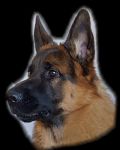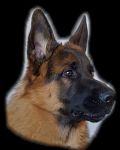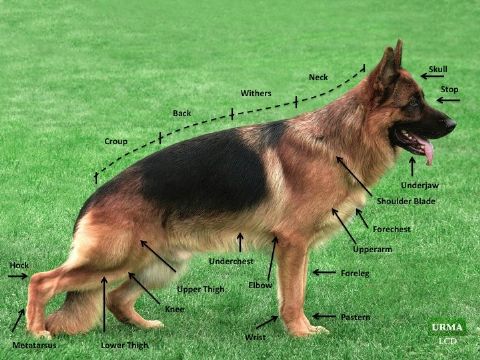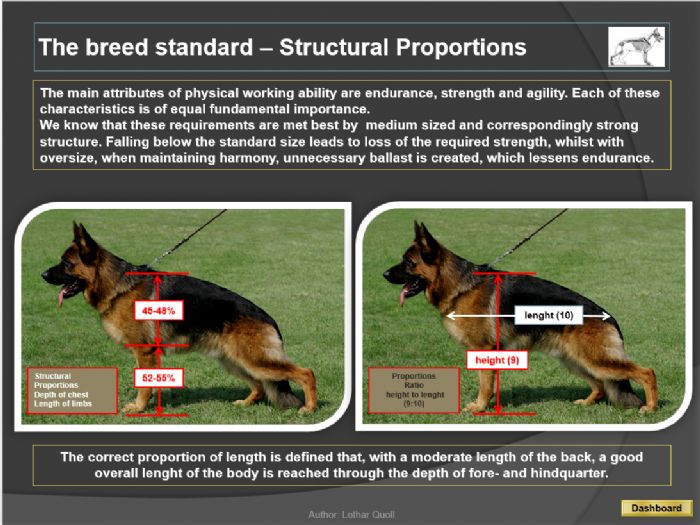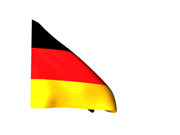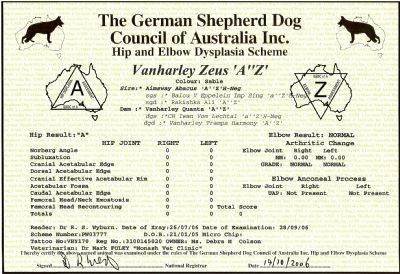|
|
GSD Schemes / The Breed
THE ABOVE PHOTO, SHOWs THE CORRECT BREED STANDARD OF THE GERMAN SHEPHERD DOG, AS SET BY THE "VEREIN FUR DEUTSCHE SCHAFERHUND" (SV). Standard below by - Herr Lothar Quoll - SV Judge and Breed Warden
BASIC ANATOMY OF THE GERMAN SHEPHERD DOG
BEFORE OUR DOGS ARE BRED THEY ARE REQUIRED TO MEET STRINGENT BREED STANDARDS, SET BY BOTH THE GERMAN SHEPHERD DOG COUNCIL OF AUSTRALIA INC. AND THE AUSTRALIAN NATIONAL KENNEL COUNCIL INC. BUT MOST IMPORTANTLY BY OURSELVES.
National Hip and Elbow Scheme The hips are scored and measured on 9 different areas on each hip, and must score under 16 in total and no more than 3 in any one area to pass. They are then given an "A" Stamp THE LOWER THE SCORE, THE BETTER THE HIPS AND ELBOWS.
Breed Survey Scheme The Breed Survey scheme, set up by the G.S.D.C of Australia Inc., is a testing system conducted for German Shepherd dogs and bitches who have achieved a pass for hips and elbows, and are aged 18 months or over. The dogs are assessed in movement as a group by a panel of Surveyors, they are required to go through a crowd of unknown people, and display no sign of fear or aggression, then stand for a gun test, where a gun is fired several times, and they must stand confidently and show no sign of anxiety or fear. The purpose of the gun test is to show steadiness of nerves which is desirable for a true all round German Shepherd. A dog may be slightly uneasy, and would still be breed worthy but would be deemed unable to work in special fields such as police work or search and rescue. After this they have Micro Chip / Ear Tattoo verified, teeth checked for correct number and spacing, are measured for correct size (not too small, not too large), weighed and have this noted. They are then individually assessed for conformation, soundness and movement, and were given a classification of Class I or Class II, which has now been changed to BREED SURVEY - PASSED, but only if they are found suitable for BREEDING. Canine Degenerative Myelopathy Canine degenerative myelopathy, also known as chronic degenerative radiculomyelopathy, is an incurable, progressive disease of the central nervous system and canine spinal cord that is similar in many ways to amyotrophic lateral sclerosis (ALS). Onset is typically after the age of 7 years and it is seen most frequently in the German Shepherd dog, Pembroke Welsh Corgi, Cardigan Corgi, Rhodesian Ridgeback, Chesapeake Bay Retrievers and Boxer Dog. The disease is an inherited recessive trait caused by mutations in the supersede dismutase one gene (SOD1 gene). Though the disorder is strongly associated with a gene mutation in SOD1 it has been found in 43 breeds as of 2008, which includes the Wire Fox Terrier. The disease presents with progressive weakness, wobbliness and incoordination of the rear limbs which are often the first signs seen in affected dogs, with staggering and scuffing of the hind limbs, which progresses over time to a state where there is also loss of reflexes in the back and flexions of the front legs, then complete paralysis. Myelin is an insulating sheath around neurons in the spinal cord. One proposed cause of degenerative myelopathy is that the immune system attacks this sheath, breaking it down. This results in a loss of communication between nerves in lower body of the animal and the brain. Most affected dogs become non mobile within 6-9 months, of the onset of the disease. "ORIVET GENETICS INFORMATION ON Degenerative Myelopathy Degenerative myelopathy is most commonly seen in the German Shepherd Dog, although other breeds are also predisposed, including the boxer, Cardigan and Pembroke Welsh Corgi, Siberian husky and the Rhodesian ridgeback. This disease is normally seen around middle age, and in general diagnosis can only be confirmed at post mortem examination. Breed surveys of some predisposed breeds indicate a fairly low occurrence rate, but most experts think this rate is actually much higher, due to the lack of post mortem follow up of the majority of suspected cases. Signs are due to the immune-mediated destruction of a part of the nerves in the spinal cord, leading to loss of these nerve fibres. The first sign is knuckling of the hind feet, and hind limb ataxia. Once the spinal cord damage progresses past this initial stage (termed proprioceptive deficits), the effectiveness (if any) of treatment is much diminished. Hence early diagnosis is vital. Following this initial stage, hind limb reflexes are affected, then weakness in the hind limbs develops, progressing to total paralysis. Once a dog shows these signs it will almost always respond poorly to therapy. Eventually destruction progresses from the middle of the spinal cord to the upper cord and brain stem, leading to forelimb weakness and eventually interference with the muscles of breathing, causing death. Most dogs are euthanased for humane reasons before this happens. Treatment is with specific supplements and drugs aimed at interfering with the immune destruction in the spinal cord, to slow further nerve damage. The effectiveness of this treatment is variable, but is only of benefit if started as early as possible. Once nerves are lost, they will not be replaced. Degenerative myelopathy cannot be cured. A DNA test is available for predisposed pure breeds to carry out screening of breeding animals." We are DNA testing our dogs and ONLY breed with a DM Clear parent. Our aim is to produce puppies that will not be effected by this disease, so by ensuring we breed with DM CLEAR Dogs, this will give us CLEAR puppies, that WILL NEVER develop this disease.
About the Breed Brief History The German Shepherd breed originated in Germany in the 1890's. A young German Cavalry officer stood on the crest of the hill, watching the sheepherder tending his flocks in the valley below. The small dogs that tended the sheep had difficulty keeping the sheep from straying and were not able to stand up to the hungry wolves that stalked the sheep. While the young officer watched he envisioned a dog of medium size who could cope with the different sized breeds of sheep found in Germany. A dog who could stand their ground against the wolves and be protective if necessary, a dog who would be extremely intelligent, quick on his feet, noble in appearence, trustworthy in character, physically sound so that he could work tirelessly all day long, and be born with an innate desire to please. A dog who could reason and be a companion to man. And so it was, this day in the 1890's the idea of founding a new breed came into being. Trainability Well bred German Shepherd's have a strong sense of loyalty and desire to please they can be trained in a variety of fields. Because of their work ethics they are widely used in police work, army dogs, mine detection, Search & rescue, etc. Their excellent nose can sniff out drugs and intruders and alert handlers to danger. They are equally at home in a family life, where they love nothing better than to be close to their family members and keep a watchful eye over them. Temperament German Shepherds are known for their tremendous loyalty and courage. They are direct and fearless, eager and alert. They are bold, happy, obedient and eager to learn. They are calmly confident with a serious demeanor and exhibit an almost human intelligence. They always want to be close to you, whether its laying beside you and relaxing, walking or playing games, it doesn't matter as long as they're close to you, they're happy. They are always ready for a ball to be thrown or just sit and have cuddles.
NOTE: This is describing a well bred German Shepherd of correct Temperament Linebreeding/Inbreeding On a 'Pedigree' you will often see dogs that are on both the Sire and Dam line of the pedigree. This is called linebreeding, and is done by a breeder to keep the qualities that a particular dog produces ie. good hips, elbows, temperament etc. It also gives and keeps a correct type. When done correctly, there should not be problems associated with the linebreeding, it should enhance established bloodlines. HOWEVER, THE SAME ANCESTOR SHOULD NOT BE IN THE FIRST THREE GENERATIONS, THIS IS TOO CLOSE AND NOT DESIRABLE. Since German Shepherds are numercally larger in number , they therefore have a greater gene pool, they don't have the need to linebreed as closely. Generally, when a particular trait is desired in the breeding program, by a breeder that has knowledge of the bloodlines and wishes to retain virtues they have in their breeding lines, it would be advantageous. As long as the "Breeder" has experience and is knowledgeable about the bloodlines they are using . Dogs have 78 Chromosomes, therefore they have a very large genetic inheritance mode, so selective linebreeding is desireable to keep the qualities within certain lines, without giving genetic abnormalities or needing to out cross. This differs greatly from humans who have 46 Chromosomes. Incidentally, fish have 94 to 101 Chromosomes, therefore abnormalies are generally NOT genetic they are congenital, if they occur.
Debra Colson Whittlesea, VIC, Australia Phone : 0419889282 Email : [email protected] |
